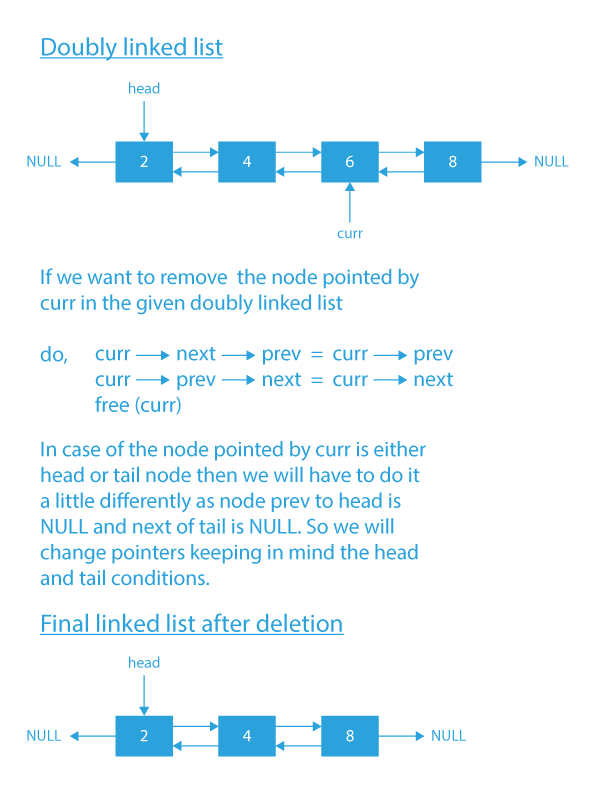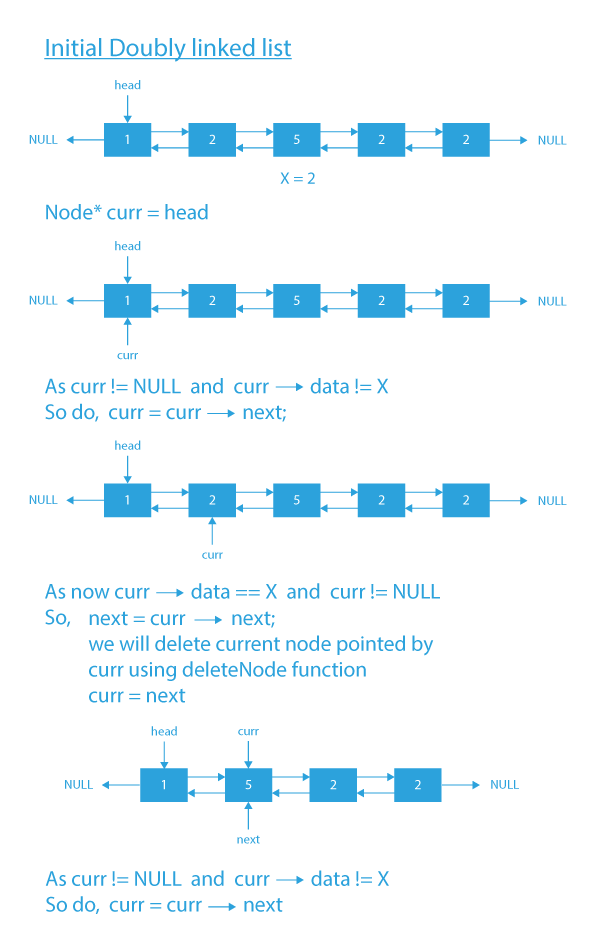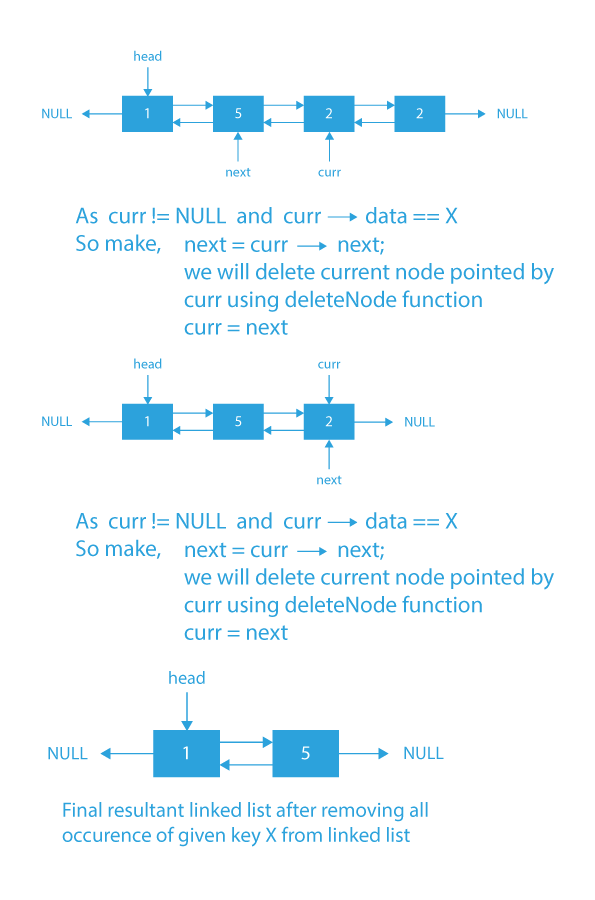Last Updated on November 24, 2023 by Ankit Kochar

Linked lists are fundamental data structures in computer science, known for their flexibility and dynamic memory allocation. Deleting the last occurrence of a specific item within a linked list involves traversing the list to find the last instance of that item and then removing it while maintaining the list’s structural integrity. This operation requires careful consideration of the pointers that connect each element of the linked list. In this article, we’ll explore methods to efficiently delete the final occurrence of an item in a linked list using various algorithms and techniques. Basically, we are given a linked list and asked to delete the last occurrence of an item X from the linked list.
How to Delete the Last Occurrence of an Item from Linked List?
We have been given a linked list and a value X. We have to delete the last occurrence of the item X from the linked list.
Let’s understand this problem with an examples.
If the linked list given to us is: head→1→2→7→5→2→10 and X = 2.
- According to the problem statement, first, we will have to find the last occurrence of X = 2 in the linked list, i.e., last node towards the end of the linked list which had node -> data == X, and then we will have to delete it from the linked list.
- Our linked list after deleting the last occurrence of X = 2 will be: head→1→2→7→5→10.
Suppose if the linked list is: head→1→3→5→7→7→7 and X=7.
- Then, in this case, after deleting the last occurrence of X = 7 from the linked list our linked list will be head→1→3→5→7→7.
Some more examples:
Sample Input 1: head→1→1→3→5→1→9, X = 1.
Sample Output 1: head→1→1→3→5→9
Sample Input 2: head→1→3→3→5→3→9→3→5→3→3, X = 3.
Sample Output 2: head→1→3→3→5→3→9→3→5→3
Now I think from the above example, the problem statement is clear. So let’s see how we will approach it.
Before moving to the approach section, try to think about how you can approach this problem.
- If stuck, no problem, we will thoroughly see how we can approach the problem in the next section.
Let’s move to the approach section.
Approach to delete the last occurrence of an item from the linked list
Our approach will be simple:
- The idea is to initialize a special pointer variable and start traversing through the linked list.
- During the traversal, Whenever the current node’s data is matching with value X, i.e., node -> data == X, move the special pointer to the current node.
- When we reach the end of the linked list, the special pointer will be pointing to the last occurrence of X in the linked list.
- Now we will have to delete the node to which special pointer is pointing.
- Finally, after deleting the node to which the special pointer points, our objective will be satisfied.
Let’s move to the algorithm section.
Algorithm to delete the last occurrence of an item from the linked list
- Initialize a pointer variable named special with NULL.
- Start traversing through the linked list.
- If the current node data is equal to value X (curr->data == X), move the special pointer to this current node.
- Continue the above step till the end of the linked list.
- When we reach the end, At that point of time, the special pointer points to the node that is the last occurring node with value X in the linked list.
- Now we have to delete that node.
- For deletion of that node, run a loop and reach the node prior to the node containing the last occurrence, i.e., the node to which special pointer is pointing.
- Now link the node before the special pointer and node after the special pointer together, and delete the special node.
- Finally, after deleting the node, our objective of deleting the last occurrence of X from the linked list will be satisfied.
Dry Run on delete the last occurrence of an item from the linked list



Implementation of delete the last occurrence of an item from the linked list
#include <stdio.h>
#include <stdlib.h>
// A linked list Node
struct Node {
int data;
struct Node* next;
};
void deleteLast(struct Node* head, int x)
{
struct Node *temp = head, *ptr = NULL;
while (temp) {
if (temp->data == x)
ptr = temp;
temp = temp->next;
}
// If the last occurrence is the last node
if (ptr != NULL && ptr->next == NULL) {
temp = head;
while (temp->next != ptr)
temp = temp->next;
temp->next = NULL;
}
// If it is not the last node
if (ptr != NULL && ptr->next != NULL) {
ptr->data = ptr->next->data;
temp = ptr->next;
ptr->next = ptr->next->next;
free(temp);
}
}
struct Node* newNode(int x)
{
struct Node* node = malloc(sizeof(struct Node*));
node->data = x;
node->next = NULL;
return node;
}
void display(struct Node* head)
{
struct Node* temp = head;
if (head == NULL) {
printf("NULL\n");
return;
}
while (temp != NULL) {
printf("%d -> ", temp->data);
temp = temp->next;
}
printf("NULL\n");
}
int main()
{
struct Node* head = newNode(1);
head->next = newNode(2);
head->next->next = newNode(7);
head->next->next->next = newNode(5);
head->next->next->next->next = newNode(2);
head->next->next->next->next->next = newNode(10);
printf("Input Linked list: ");
display(head);
deleteLast(head, 2);
printf("List after deletion of 4: ");
display(head);
return 0;
}
#include <bits/stdc++.h>
using namespace std;
// A linked list Node
class Node {
public:
int data;
Node* next;
};
void deleteLast(Node* head, int X){
// Initialize special pointer with NULL
Node* special = NULL;
// Start from head and find the last Occurrence
// of node with value X
Node* temp = head;
while (temp) {
// If we found the key, update special
if (temp->data == X)
special = temp;
temp = temp->next;
}
// key occurs at-least once
if (special != NULL) {
Node* removeNode = head;
while(removeNode->next != special){
removeNode = removeNode->next;
}
removeNode->next = special->next;
special->next = NULL;
delete special;
}
}
// function to create a new node with given data
Node* newNode(int data){
Node* temp = new Node;
temp->data = data;
temp->next = NULL;
return temp;
}
// function to print the linked list
void printList(Node* node){
while (node != NULL) {
cout<<node->data<<" ";
node = node->next;
}
}
int main(){
Node* head = newNode(1);
head->next = newNode(2);
head->next->next = newNode(7);
head->next->next->next = newNode(5);
head->next->next->next->next = newNode(2);
head->next->next->next->next->next = newNode(10);
cout<<"Input Linked List: ";
printList(head);cout<<endl;
deleteLast(head, 2);
cout<<"Output Linked List: ";
printList(head);
return 0;
}
class DeleteOccurances
{
static class Node
{
int data;
Node next;
};
// Function to delete the last occurrence
static void deleteLast(Node head, int x)
{
Node temp = head, ptr = null;
while (temp!=null)
{
// If found key, update
if (temp.data == x)
ptr = temp;
temp = temp.next;
}
// If the last occurrence is the last node
if (ptr != null && ptr.next == null)
{
temp = head;
while (temp.next != ptr)
temp = temp.next;
temp.next = null;
}
// If it is not the last node
if (ptr != null && ptr.next != null)
{
ptr.data = ptr.next.data;
temp = ptr.next;
ptr.next = ptr.next.next;
System.gc();
}
}
static Node newNode(int x)
{
Node node = new Node();
node.data = x;
node.next = null;
return node;
}
static void display(Node head)
{
Node temp = head;
if (head == null)
{
System.out.print("null\n");
return;
}
while (temp != null)
{
System.out.printf("%d --> ", temp.data);
temp = temp.next;
}
System.out.print("null\n");
}
/* Driver code*/
public static void main(String[] args)
{
Node head = newNode(11);
head.next = newNode(2);
head.next.next = newNode(3);
head.next.next.next = newNode(4);
head.next.next.next.next = newNode(5);
head.next.next.next.next.next = newNode(4);
head.next.next.next.next.next.next = newNode(4);
System.out.print("Created Linked list: ");
display(head);
deleteLast(head, 4);
System.out.print("List after deletion of 4: ");
display(head);
}
}
class Node:
def __init__(self, new_data):
self.data = new_data
self.next = None
def deleteLast(head, x):
temp = head
ptr = None
while (temp != None):
if (temp.data == x):
ptr = temp
temp = temp.next
if (ptr != None and ptr.next == None):
temp = head
while (temp.next != ptr):
temp = temp.next
temp.next = None
if (ptr != None and ptr.next != None):
ptr.data = ptr.next.data
temp = ptr.next
ptr.next = ptr.next.next
return head
def newNode(x):
node = Node(0)
node.data = x
node.next = None
return node
def display(head):
temp = head
if (head == None):
print("NULL\n")
return
while (temp != None):
print( temp.data, end = " ")
temp = temp.next
print("NULL")
head = newNode(1)
head.next = newNode(2)
head.next.next = newNode(7)
head.next.next.next = newNode(5)
head.next.next.next.next = newNode(2)
head.next.next.next.next.next = newNode(10)
print("Created Linked list: ", end = '')
display(head)
# Pass the address of the head pointer
head = deleteLast(head, 2)
print("List after deletion of 4: ", end = '')
display(head)
Output
Input Linked List: 1 2 7 5 2 10
Output Linked List: 1 2 7 5 10
Time Complexity: O(N), Since we traversed through the list two times, One traversal for finding the last occurred node of value X in the linked list and another traversal for the deletion process.
Conclusion
Deleting the last occurrence of an item in a linked list involves a nuanced approach that combines careful traversal and pointer manipulation. By understanding the intricacies of the linked list structure and employing appropriate algorithms, it’s possible to achieve this deletion efficiently. Throughout this article, we’ve explored different strategies and code implementations to accomplish this task. It’s important to choose a method that suits the specific context and requirements of the application, considering both time and space complexity. Mastering these techniques can enhance a programmer’s ability to work with linked lists and solve related challenges effectively.
FAQs (Frequently Asked Questions) Related to Delete Last Occurrence of an Item from the Linked List
Here are some FAQs (Frequently Asked Questions) Related to Delete Last Occurrence of an Item from the Linked List.
Q1: Why is deleting the last occurrence of an item in a linked list important?
Deleting the last occurrence of an item in a linked list can be crucial for various applications, especially when maintaining a specific order or sequence of elements. For instance, in certain tasks related to data management or processing, removing the last instance of an item might impact the integrity or relevance of the information being processed.
Q2: Are there any particular challenges when deleting the last occurrence of an item?
Yes, there can be challenges, especially in scenarios where the linked list is large or when dealing with edge cases, such as the item being the only element in the list or being present multiple times consecutively at the end. Careful handling of pointers and edge case scenarios is essential for accurate deletion.
Q3: What are some common strategies to delete the last occurrence of an item in a linked list?
One approach involves traversing the linked list while maintaining pointers to track the last occurrence of the item and its preceding node. Another method includes utilizing recursion to locate the last instance and perform deletion. Selecting the appropriate strategy often depends on the specific requirements and constraints of the problem at hand.
Q4: How can I ensure the correctness of my implementation when deleting the last occurrence of an item?
Testing your code extensively with various scenarios, including edge cases and different types of linked lists, is crucial. Validating the functionality through test cases and considering potential corner cases will help ensure the correctness and robustness of your implementation.


